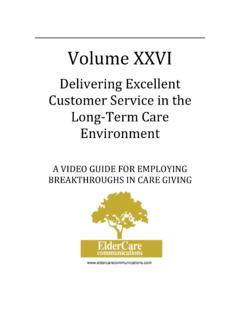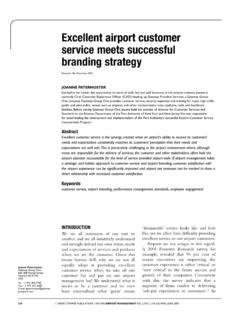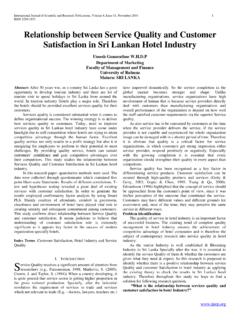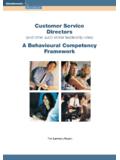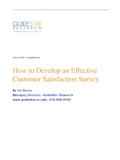Transcription of CUSTOMER SERVICE EXCELLENCE
1 CUSTOMER SERVICE EXCELLENCE STANDARD. 2. Table of Contents The starting point 4. Criterion 1 CUSTOMER Insight 5. CUSTOMER Identification 5. Engagement and Consultation 6. CUSTOMER Satisfaction 7. Criterion 2 The Culture of the Organisation 8. Leadership, Policy and Culture 8. Staff Professionalism and Attitude 9. Criterion 3 Information and Access 10. Range of Information 10. Quality of Information 10. Access 11. Co-operative working with other providers, partners and communities 11. Criterion 4 Delivery 12. Delivery standards 12. Achieved Delivery and Outcomes 13. Deal effectively with problems 13. Criterion 5 Timeliness and Quality of SERVICE 15. Standards for Timeliness and Quality 15. Timely Outcomes 15. Achieved Timely Delivery 16. 3. The CUSTOMER SERVICE EXCELLENCE Standard The starting point As a skills development tool By allowing individuals and teams within the Organisations providing services need to be efficient, organisation to explore and acquire new skills in the effective, excellent , equitable, with the CUSTOMER at area of CUSTOMER focus and CUSTOMER engagement, the heart of everything they do.
2 A CUSTOMER focus thus building their capacity for delivering improved principle plays just as important a role for small front- services . line units as it would for large corporate organisations. As an independent validation of achievement CUSTOMER SERVICE EXCELLENCE was developed to offer By allowing organisations to seek formal accreditation all organisations a practical tool for driving CUSTOMER - to the CUSTOMER SERVICE EXCELLENCE standard, focused change. demonstrate their competence, identify key areas for The foundation of this tool is the CUSTOMER SERVICE improvement and celebrate their success. EXCELLENCE standard, which is a mix of research, management and operational models and, most Who can apply? importantly, practical experience of providing services . CUSTOMER SERVICE EXCELLENCE aims to provide The standard has particular focus on delivery, organisations with a practical tool for driving CUSTOMER timeliness, information, professionalism and staff focused change.
3 The standard has been specifically attitude. There is also emphasis placed on developing designed to offer real benefits to all organisations, no CUSTOMER insight, understanding the user's experience matter how big they are or what sector they work in. and robust measurement of SERVICE satisfaction. The standard includes guidance to help you identify evidence against each element. However, it is not meant How does it work? to be a full list of all the different types of evidence. CUSTOMER SERVICE EXCELLENCE is designed to operate on three distinct levels: How to apply? As a driver of continuous improvement For more information on achieving CUSTOMER SERVICE By allowing organisations to self-assess their EXCELLENCE please see the contact details on page 17 or capability, in relation to CUSTOMER -focused SERVICE visit delivery, by identifying areas and methods for improvement.
4 4. Criterion 1 CUSTOMER Insight This criterion focuses on the importance of developing an in-depth understanding of your customers. This includes consulting customers and using the information you receive to design and provide services . It also covers the importance of monitoring the outcomes of your services and whether customers are satisfied with them. Understanding customers in this way is essential for SERVICE providers, enabling them to raise their standards and levels of SERVICE and continue to build on this success. Effectively identifying your customers, consulting them in a meaningful way and efficiently measuring the outcomes of your SERVICE are a vital part of this approach. It is not just about being able to collect information. It is about having the ability to use that information, and developing a culture within your organisation that values this kind of understanding and constantly looks to improve.
5 Criterion 1 CUSTOMER Insight CUSTOMER Identification Element Guidance We have an in-depth understanding of A profile of the organisation's main CUSTOMER groups the characteristics of our current and and their characteristics. potential CUSTOMER groups based on Details of how these groups were segmented and recent and reliable information. classified. Details on the frequency and reliability of the research to identify CUSTOMER groups. We have developed CUSTOMER insight Methods and approaches used for developing about our CUSTOMER groups to better understanding, such as focus groups, one-to-one understand their needs and preferences. interviews, surveys, observation, CUSTOMER journey mapping and other ways of collecting information about customers. Details of how you improved your services as a result of the understanding you gained into your customers' needs.
6 We make particular efforts to identify Methods used to consult and involve hard-to-reach hard-to-reach and disadvantaged groups and disadvantaged groups and individuals, particularly and individuals and have developed our people who have a number of different needs and services in response to their specific customers whose views you rarely hear. needs. Examples of how you identified needs that you were not meeting and the changes you made to avoid excluding or under-representing certain people. 5. Engagement and Consultation Element Guidance We have a strategy for engaging and Policies, strategies and leadership for engaging, involving customers using a range of consulting and involving CUSTOMER groups. methods appropriate to the needs of Evidence of how you use a wide range of tools, identified CUSTOMER groups. including feedback from customers and staff (letters, e-mails, comments, complaints, forums, focus groups and so on) as well as research.
7 We have made the consultation of Findings and analysis of engagement activity, customers integral to continually consultation exercises and other methods for improving our SERVICE and we advise capturing feedback. customers of the results and action Details of actual improvements, with evidence of taken. how these are directly linked to the ways you consulted and involved customers. Examples of how you involved customers in designing and providing services (for example, through allowing them to take part). Information on how you tell customers about the changes you make as a result of their involvement. Current SERVICE improvement and development plans showing that your policies, projects and activities are shaped by how you consult and involve customers. We regularly review our strategies and Outcome of reviews on the effectiveness of opportunities for consulting and engaging engagement and involvement, showing levels of with customers to ensure that the participation, assessment of how representative the methods used are effective and provide results are, and quality of information collected.
8 Reliable and representative results. How mechanisms, processes and approaches are adapted to respond to emerging issues, SERVICE priorities, demographic changes etc. Examples of innovation, learning from best practice or benchmarking, suggestions of staff etc. 6. CUSTOMER Satisfaction Element Guidance We use reliable and accurate methods to Methods used would in most cases include survey measure CUSTOMER satisfaction on a work and other forms of feedback and qualitative regular basis. information. Information on survey methodology, for example sample sizes, potential biases, margins of error and any advice taken on design. Reasons for the decisions you made on how to measure customers' satisfaction. Details on how often you collected information We analyse and publicise satisfaction Assessment and analysis of satisfaction within all levels for the full range of customers for groups (identified).
9 All main areas of our SERVICE and we have If you provide a range of different services , you should improved services as a result. assess how satisfied customers are with all of them. Evidence of any differences in levels of satisfaction between groups, or any unexpected outcomes. Published information about the action you plan to take or have taken as a result of measuring customers' satisfaction with your SERVICE . Examples of other methods you used. We include in our measurement of Satisfaction surveys and other ways of gathering satisfaction specific questions relating to feedback that include these specific questions. key areas including those on delivery, Evidence of investigation into customers' priorities timeliness, information, access, and the and local key drivers of satisfaction. quality of CUSTOMER SERVICE , as well as specific questions which are informed by CUSTOMER insight.
10 We set challenging and stretching targets Satisfaction levels of all CUSTOMER groups for all the for CUSTOMER satisfaction and our levels main areas of your SERVICE , and the targets you want are improving. to achieve. Evidence of how levels of satisfaction have improved over time. We have made positive changes to Examples of how you analyse customers'. services as a result of analysing CUSTOMER experience. experience, including improved Specific information on how you map customers'. CUSTOMER journeys. journeys and the steps you have taken to improve these (for example, through limiting the amount of unnecessary contact they have with people in your organisation). Any evidence of savings or reinvestment (or both) as a result of making your systems and processes more efficient. 7. Criterion 2 The Culture of the Organisation A CUSTOMER focused culture can be challenging but at its core is a business model based on a detailed understanding of customers.
